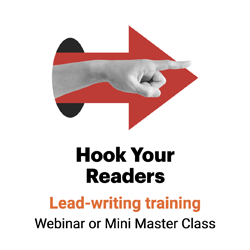Concrete leads are the price of entry for feature articles
I was training a group of magazine writers recently, when one brave soul, Marty, shared this lead:

As someone who’s built build models in some exotic places, I know it’s easier when you have a special modeling studio.
“Hmmm …,” I said, “Exotic places, huh? Where are some of the most exotic places you’ve built models?”
“On a battleship during a storm,” Marty answered. “In a tent in Saudi Arabia. Under my blanket as a kid when I was supposed to be doing my homework.”
“Marty,” I said, “that’s your lead.”
Perhaps nothing is harder about writing a feature-style story than showing in the lead and telling in the nut graph. Illustrate, then explain. Most writers do the reverse.
Avoid Yup leads.
But if the price of entry to a feature story is a concrete lead, then abstract leads won’t do the job. Avoid dry, boring, abstract leads like:
In agriculture and the general economy, change can happen fast, and when it does, the ripples are often felt in the value of collateral.
I call these Yup leads, as in, Yup! I’m sure that’s true — I just don’t want to know any more about it!
And:
Our industry is in the midst of a major transformation, and no one is closer to this than you.
And:
Our industry is facing problems that are already affecting our ability to provide good, reliable air transportation service. There are problems that must be addressed and must be addressed now.
And:
The topic of energy, and the role of natural gas in the U.S. energy picture is both complex and fascinating.
For gosh sakes, don’t tell me it’s fascinating. Fascinate me!
Avoid Duh leads.
Another subset of abstract leads are Duh leads. They’re patronizing as well as dull. These leads trigger the Duh reflex:
Work on a new company doesn’t end once you’ve launched the business.
Oh, really? I thought I’d slap a logo on the door and wait for the cash to flood in.
As our business continues to transform, our success depends on our ability to sustain great performance.
Great performance! Good to know! I was planning on going the other direction, so it’s nice to get the clarification.
Summer is here!
Thanks for telling me! My cubicle doesn’t have a window, so I count on the employee newsletter to alert me to what season it is.
If your lead triggers your readers’ “duh” reflex, write another lead.
Turn ideas into things.
Abstract leads like these focus on ideas. But, as American poet William Carlos Williams counseled, readers understand “no ideas but in things.”
The communicator’s job, then, is to turn ideas into things. Don’t start wide, then go granular. Lead with the specifics, then expand into generalities. Show in the lead; tell in the nut graph.
Check your lead.
Does your lead show or tell?
- Is your lead concrete? Can you see it, taste it, smell it, feel it, hear it? Or is it a startling statistic? If not, chances are, it’s abstract.
- Do your eyes roll back in your head as you read this lead? Do you feel at once bored and patronized? If so, it may be a Yup or a Duh
- How can you turn your idea into a thing? How can you illustrate your idea — instead of just telling about it — with these 7 types of concrete, creative and provocative leads to try:
- Anecdotal leads: To draw readers in, tell them a story.
- Descriptive leads: Take readers to the scene by painting a picture.
- Human interest: Find a poster person to make your point.
- Juicy details: Color readers interested with fun facts.
- Metaphor: Clarify complex concepts with comparisons.
- How to write a good feature lead with statistics: Prove it with a data point
- Wordplay: Surprise and delight your readers.
Feature leads are concrete.
You’re not covering the police officers’ beat for the daily news. You’re not handling news writing for The New York Times. Most of the time, you’re writing feature stories.
So give those feature articles solid feature leads. Make them concrete, not abstract. Show, don’t tell.

Leave a Reply